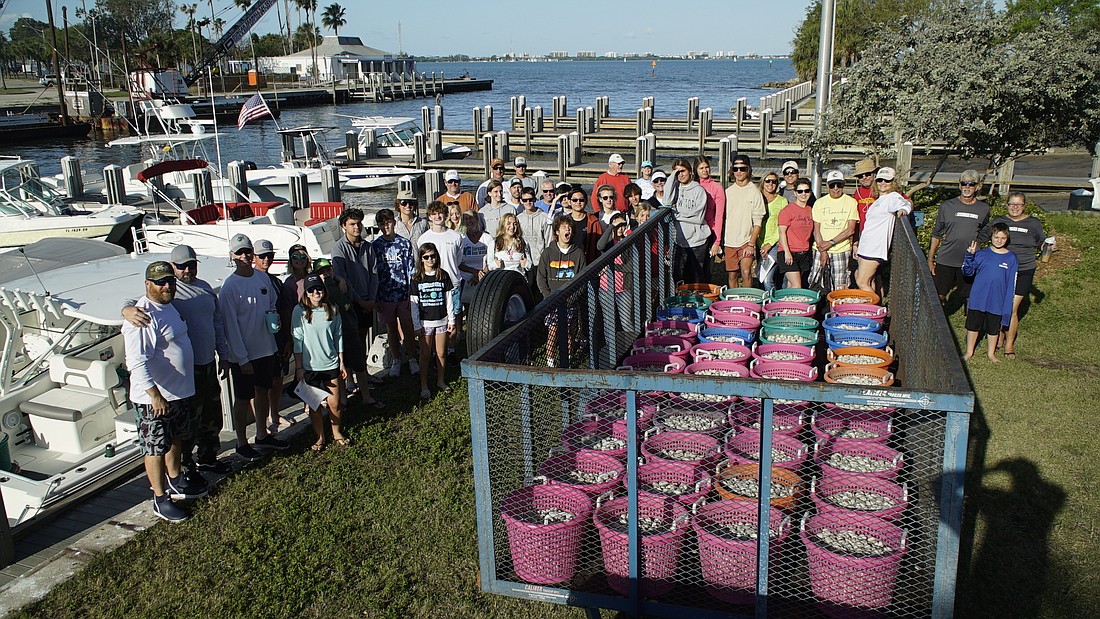- May 28, 2025
-
-
Loading

Loading

With funds from its February fundraiser, Sarasota Bay Watch started releasing clams in Sarasota Bay last weekend to help restore water quality last Saturday and will continue to do so every other weekend until 1 million clams are released.
Sarasota Bay Watch sent 44 people on 10 boats to two locations on Sarasota Bay to drop clams. But the process of using clams to improve water quality started long before the releasing process, according to Sarasota Bay Watch Executive Director Ronda Ryan.
“You take the clams that have been brought up by the farmer, and you put it through a machine to get rid of dead shells and miscellaneous growth,” Ryan said. “That makes for a much cleaner product and that’s how we do our approximations. We did that for about five hours on Friday.”
Also in preparation, Sarasota Bay Watch evaluated historical maps of sea grass to know where not to drop the clams. Because sea grass growth is in decline and clams can improve sea grass growth, clams were placed where the plant is not present.
A dive team then evaluated the area before the releases took place. On Saturday, the group made up of volunteers, scientists and students met at Sarasota's 10th Street boat ramp to begin the releasing process.
“We do these studies ahead of time and then go out on the boat with the dive team and the scientists,” Ryan said. “We’re looking at very specific densities and the divers evaluate the sediment. We’re very careful with how many clams we drop at each site.”
As of Monday, Sarasota Bay Watch has released about 250,000 clams. Its goal is to release the 1 million clams it has gained funding for by the end of July.
Sarasota Bay Watch uses Southern hard-shell clams, which are native to Sarasota-area waters. When clams can naturally clean the water, it can allow sunlight to reach aquatic plants, which is vital for the overall health of Sarasota Bay.
“You don’t want to place clams in areas with seagrass. You want to place them in areas that are sandier,” Ryan said. “Hopefully, with some luck the seagrass will come later. If you clear the water so that sunlight can penetrate it, you can encourage plant growth.”
Farmers who raise the clams wait for them to grow to a size of about 2 inches before they move forward in the process. If they were not allowed to grow beforehand, they would be at a size that marine animals would eat them, which would be counterproductive to restoration process.
Among the 44 people present for Saturday’s release, many were students from local middle and high schools. While Sarasota Bay Watch has committed ample time for its current projects, education has been a priority for future generations to care for the waters.
“It’s important that we get these young people educated, help them know what the water is supposed to look like,” Ryan said. “We need to do that because when our older population is gone, it will be the younger population’s responsibility. Students are a big art of what we do.”
Although scheduled for every other weekend, clam release dates could vary between Saturdays and Sundays. Weather also has played a factor, as well as other projects Sarasota Bay Watch has prioritized.
For example, Sarasota Bay Watch planned to make progress on a Neville Preserve cleanup project this week, but it was cancelled due to weather. Sarasota Bay Watch is also working on a Sister Key cleanup project.
“While we have this vigorous clam restoration project going on, we’re still staying true to other events we like to do and other partners who are working with us,” Ryan said. “It’s all super exciting and we’ll be in the giving challenge later in the month.”
Sarasota Bay Watch is a nonprofit relying on donations to operate. The bulk of its funding comes from the annual Scallopalooza fundraiser that takes place in February.
This year, Helios Technology donated $10,000 toward the clam water restoration project, which provided Sarasota Bay Watch with the 1 million clam estimate in its plan. More than 400 people donated and attended the event this year, where they learned how clams can work.
“We placed a vase filled with algae at each table at the fundraiser. You couldn’t see through it at all,” Ryan said. “Once the clams were placed in the water, the water was completely clear in 30 minutes. I think that showed all you need to know.”
More information about Sarasota Bay Watch can be found on its website at SarasotaBayWatch.org.